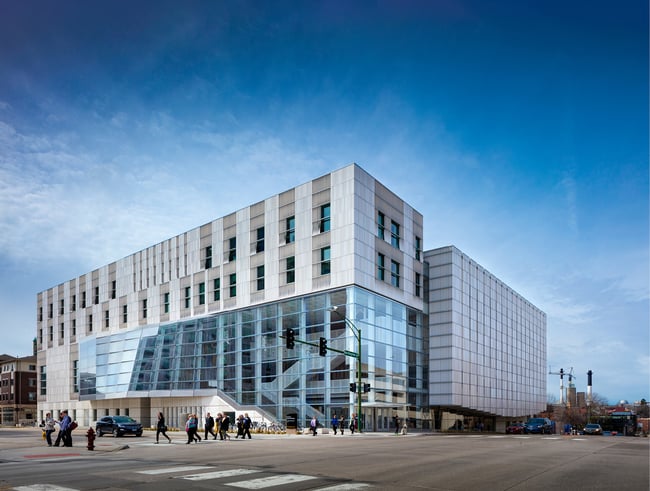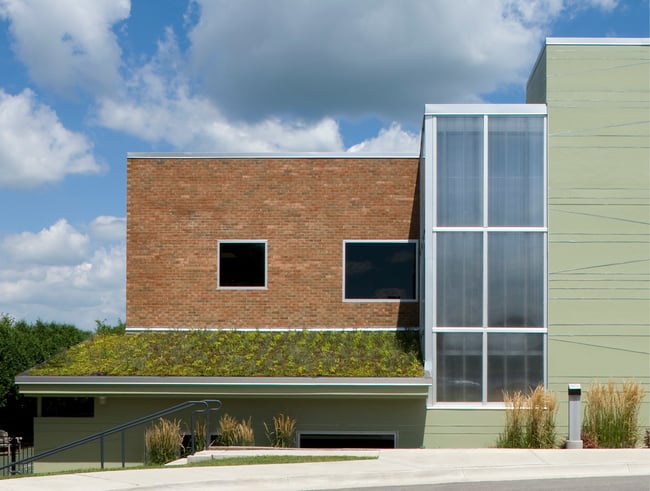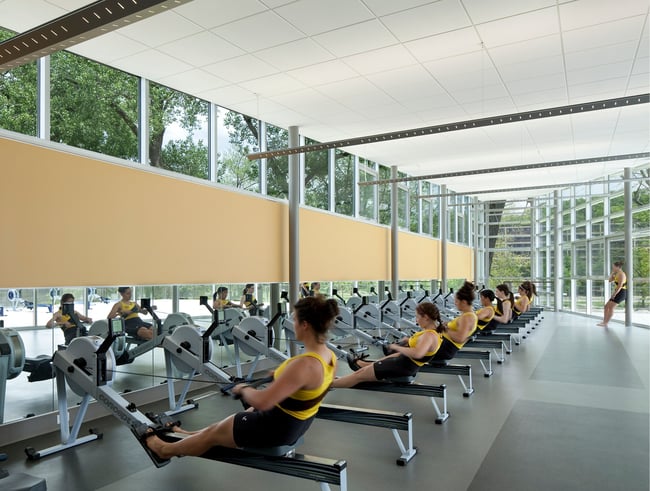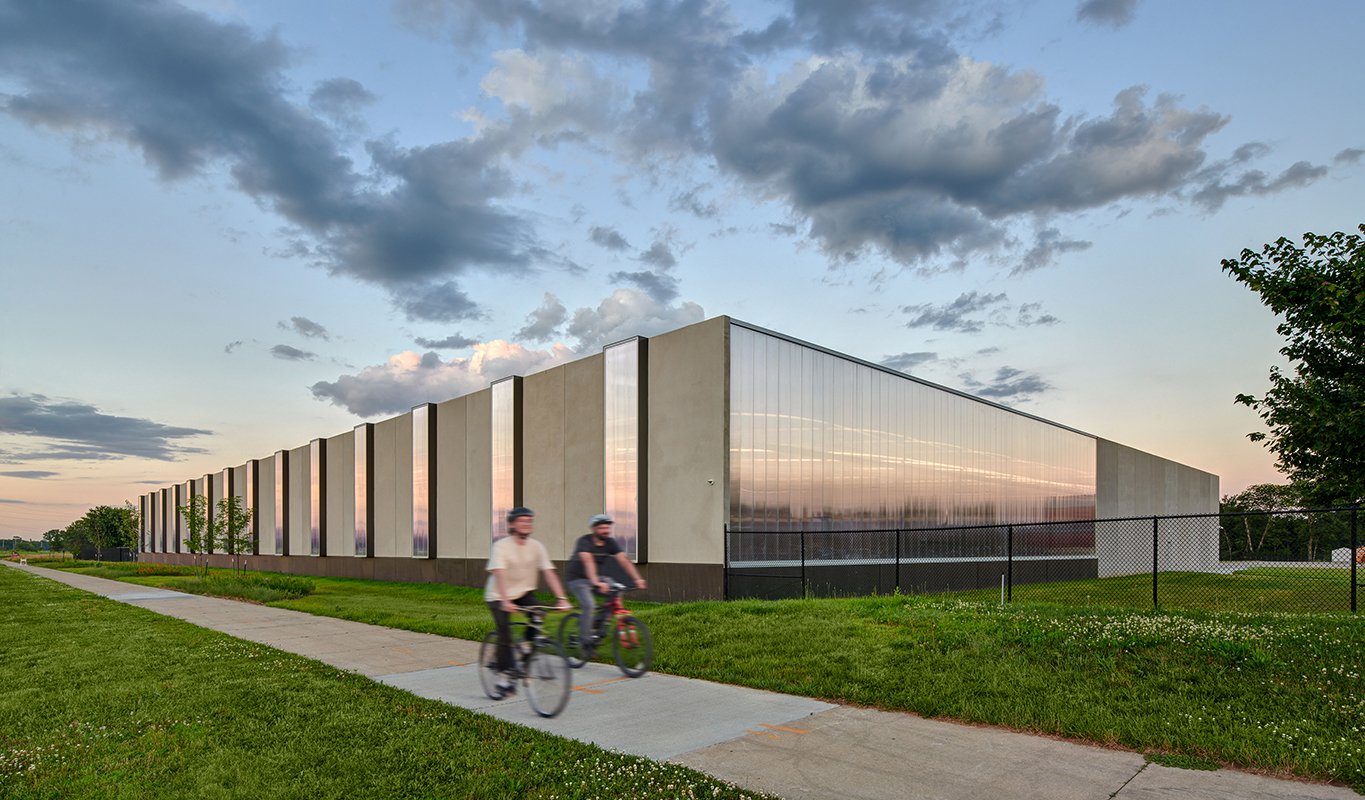LEED’s Six Certification Pathways
LEED is a robust green building certification system, designed to fit any project type or scale. Its six certification pathways address different typologies—from single-family homes to entire cities.
1. Building Design and Construction
The Building Design and Construction certification pathway addresses new, larger-scale building projects, like schools, healthcare facilities, and larger commercial developments. It also covers major renovations.
2. Interior Design and Construction
The Interior Design and Construction pathway covers smaller interior fit-out projects. Retail, hospitality, and smaller commercial projects fall under its umbrella, especially those in leased spaces.
3. Building Operations and Maintenance
The Building Operations and Maintenance certification pathway covers existing buildings. Points are awarded for managing building and site conditions and creating long-term plans for improving energy efficiency.
4. Neighborhood Development
The Neighborhood Development pathway focuses on land developments and redevelopments. It fits district planning projects, including residential, industrial, mixed-use, and commercial developments.
5. Homes
The Homes pathway addresses single-family homes, as well as low-rise and mid-rise multifamily developments. Large residential developments fall under the New Design and Construction certification pathway.
6. Cities
The LEED for Cities pathways covers entire cities or sub-sections of a city. It measures a city’s overall water consumption, energy use, and waste management strategies, as well as transportation and human experience. Washington DC, for example, became the first LEED Platinum city in 2017.
LEED’s Nine Categories
LEED is a holistic rating system that addresses everything from site development to energy performance and occupant well-being. To achieve a LEED certification, projects must adhere to the prerequisite requirements. Projects can earn additional points by fulfilling non-required strategies outlined in LEED’s nine categories.
Depending on the number of points achieved, projects can earn one of four certifications:
- Certified (40-49 points)
- Silver (50-59 points)
- Gold (60-79 points)
- Platinum (80+ points)
Below, we’ll discuss LEED’s nine categories and highlight its prerequisites.
1. Integrated Process
Projects can earn points for using an integrated project delivery method. LEED encourages architects, engineers, and contractors to take part in the process with the building owner from the beginning to create a collaborative approach to design and construction.
2. Location and Transportation
The Location and Transportation category encourages projects to develop in existing areas near amenities and public transportation. Projects can earn points by selecting a site in a dense area, providing bicycle storage, and reducing parking.

Voxman School of Music, located in a walkable downtown area.
These strategies minimize the carbon emissions associated with commuting and protect sensitive lands like farmlands, floodplains, and natural habitats.
3. Sustainable Sites
The Sustainable Sites category focuses on building site development and management. As a prerequisite, projects must reduce construction activity pollution.

A green roof a Willowwind mitigates urban heat islands.
Projects can earn additional points for protecting and restoring natural habitats, managing rainwater, reducing light pollution and heat islands, and providing open space for occupants.
4. Water Efficiency
The Water Efficiency category covers outdoor and indoor water use. It encourages water use reduction, rainwater management, and the appropriate use of non-potable water sources. Its prerequisites include indoor water use reduction, outdoor water use reduction, and building-level water metering.
5. Energy and Atmosphere
Energy and Atmosphere is the most weighted LEED category, offering the highest number of points. Its goal is to improve building performance and reduce operational carbon emissions.
Prerequisites include minimum energy performance requirements, building-level energy metering, fundamental refrigerant management, and commissioning and verification. Projects can earn additional points for exceeding minimum requirements, optimizing performance, and incorporating renewable energy systems.
6. Materials and Resources
The Materials and Resources category addresses waste management and material sourcing. Projects are required to manage construction waste and store and collect recyclables.
Additional points are available for utilizing existing buildings, prioritizing Environmental Product Declarations, and sourcing raw materials responsibly. Learn more about material research by reading about the AIA’s Architecture & Design Materials Pledge.
7. Indoor Environmental Quality
The Indoor Environmental Quality category focuses on occupant health and well-being. It sets minimum requirements for air quality performance and tobacco smoke control.

Operable windows at Beckwith Boathouse let in fresh air and daylight.
Projects can also earn points for incorporating daylighting strategies, using low-emitting materials, and improving thermal comfort and acoustic performance.
8. Innovation
Occasionally projects go above and beyond or incorporate novel strategies not outlined in LEED’s current framework. The Innovation category awards points for unique approaches to sustainable design.
9. Regional Priority
Lastly, the Regional Priority category incentivizes projects to address geographically specific environmental priorities. These priorities are based on zip code and determined by local USGBC members. In Iowa, for example, rainwater management is a regional priority.
Learn More About LEED
For building owners looking for an approach to sustainable design, LEED is an accessible option. As the oldest and most popular green building rating system, many design and construction professionals are familiar with its requirements.
Its six certification pathways fit any project type or scale, and its nine categories cover every aspect of sustainable design. This holistic yet flexible framework aligns well with most projects.
Like any green building rating system, LEED can add a layer of complexity to a project. Building owners should understand its requirements and associated costs at a project’s onset. Determine if the system is right for you by reading about the factors to consider before pursuing LEED.

